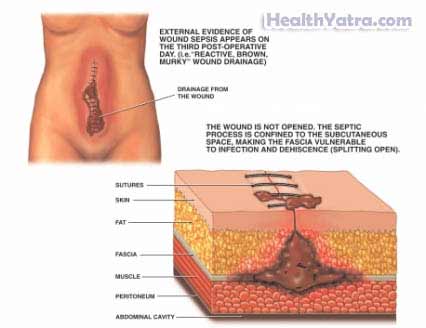Definition
Wound dehiscence is the parting of the layers of a surgical wound. Either the surface layers separate or the whole wound splits open. This is a serious condition and requires care from your doctor.
Causes
Wound dehiscence varies depending on the kind of surgery you have. The following is a list of generalized causes:
- Infection at the wound
- Pressure on sutures
- Sutures too tight
- Injury to the wound area
- Weak tissue or muscle at the wound area
- Incorrect suture technique used to close operative area
- Poor closure technique at the time of surgery
- Use of high-dose or long-term corticosteroids
- Severe vitamin C deficiency (scurvy)

Risk Factors
The following factors increase your chance of developing wound dehiscence.
- Overweight
- Increasing age
- Poor nutrition
- Diabetes
- Smoking
- Malignant growth
- Presence of prior scar or radiation at the incision site
- Non-compliance with post-operative instructions (such as early excessive exercise or lifting heavy objects)
- Surgical error
- Increased pressure within the abdomen due to: fluid accumulation (ascites); inflamed bowel; severe coughing, straining, or vomiting
- Long-term use of corticosteroid medications
- Other medical conditions, such as diabetes, kidney disease, cancer, immune problems, chemotherapy, or radiation therapy
Symptoms
If you experience one or more of these symptoms in the surgical area, contact your doctor.
- Bleeding
- Pain
- Swelling
- Redness
- Fever
- Broken sutures
- Open wound
Diagnosis
Your doctor will ask about your symptoms and examine the surgical area. Tests may include the following:
- Laboratory tests, such as:
- Wound and tissue cultures to determine if there is an infection
- Blood tests to determine if there is an infection
- Imaging studies, such as:
- X-ray—to evaluate the extent of wound separation
- Ultrasound—to evaluate for pus and pockets of fluid
- CT scan—to evaluate for pus and pockets of fluid
Treatment
- Drug therapy
- Antibiotic therapy
- Medical treatment
- When appropriate, frequent changes in wound dressing to prevent infection
- When appropriate, wound exposure to air to accelerate healing and prevent infection, and allow growth of new tissue from below
- Surgical intervention
- Surgical removal of contaminated, dead tissue
- Resuturing
- Placement of a temporary or permanent piece of mesh to bridge the gap in the wound
If you are diagnosed with wound dehiscence, follow your doctor’s instructions .
Prevention
- When appropriate, have antibiotic therapy prior to surgery.
- When appropriate, have antibiotic therapy after surgery.
- When using wound dressing, maintain light pressure on wound.
- Keep wound area clean.
- Comply with post-operative instructions.
